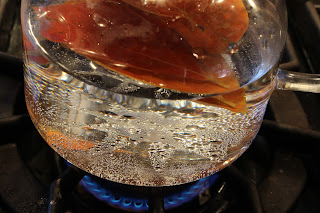Persimmon leaves tea is one of my favorite teas that I make in autumn through winter.
The tea can be made with fresh leaves or dried ones. When I make the tea with fresh leaves I
harvest the leaves, clean or wash them and use 5~6 fresh leaves with 4 cups of purified boiling water simmer or brew for 10~15 minutes. When I use dried leaves then I use 4 teaspoon of the dried leaves for each 4 cups of boiling water and simmer or brew for 10~15 minutes. Drink a cup or more of the tea daily.
Persimmon tea contains a high quantity of Vitamin C, tannins, flavonoids, rutin, choline carotenoids, amino acids. In addition, the tea were found to contain 10 elements: Magnesium (Mg), Manganese (Mn), titanium (Ti), calcium (Ca), phosphorous (P), and more. These elements are found to aid to healthy bodily functions.
I also heard that compared to other teas, persimmon leaf tea contains a higher level of health and nutritional benefits. Analysis has shown persimmon leaf tea contains up to 10 times the amount of Vitamin C, tannins, flavonoids, rutin, choline and essential amino acid. Compared to other fruits and vegetables, persimmon leaf tea contains up to several times more vitamins.
Scientific research has shown that drinking persimmon leaf tea promotes a healthy metabolism. Rutin aids in softening the blood choline tube, which prevents arteriosclerosis. Flavonoids aid in lowering blood pressure and increase blood flow. According to Japan’s “Longevity” magazine, drinking persimmon leaf tea and prevent melanoma. These health benefits generate anti-cancer and anti-influenza virus interferons.
All the benefits are helpful, but I make persimmon tea because I love the taste also. You can purchase it natural food store or internet shop so I hope you enjoy them like I do.
Love,
Sanae








2 comments:
Unfortunately by these pictures, you may be suggesting that the fall leaves (when leaves turn a beautiful orange) be used for tea. However, at this time in the year, the leaves are now old and their nutrient value is low. It is the spring green leaves that are used for tea, before the tree’s energy turns to ripening the fruit. Best-
Most of the people in FB persimmon group prefer fall orange persimmon leaves, not the young spring / summer leaves.
What is the best way to dry persimmon leaves? Just to place them on something flat inside?
Post a Comment